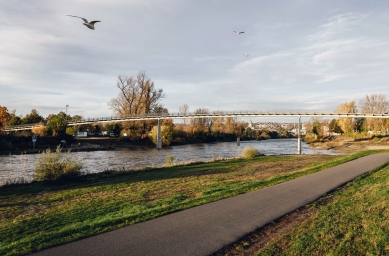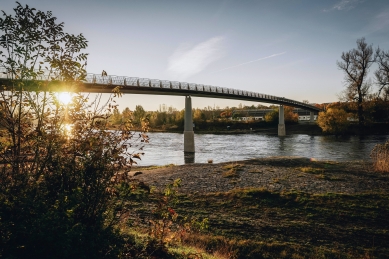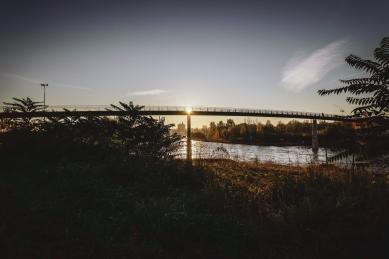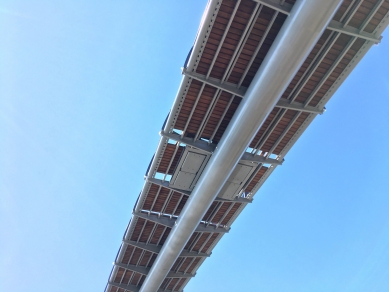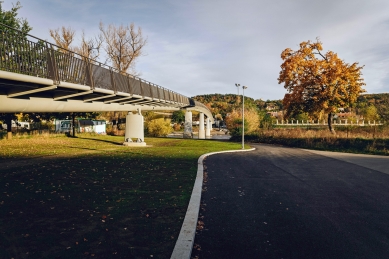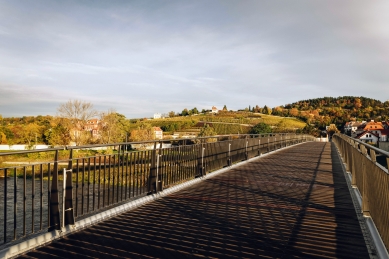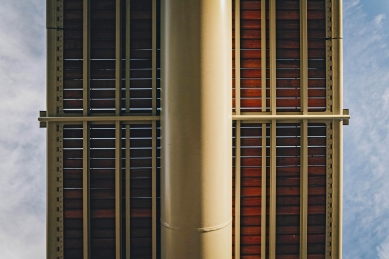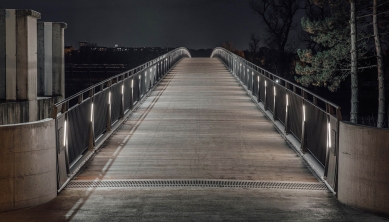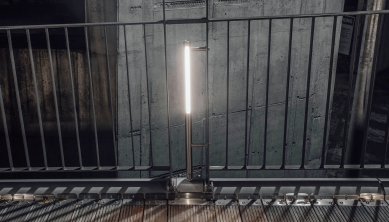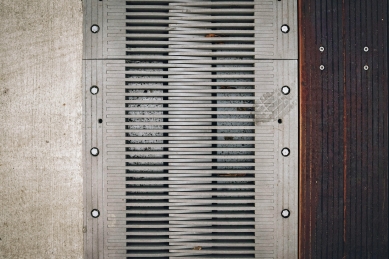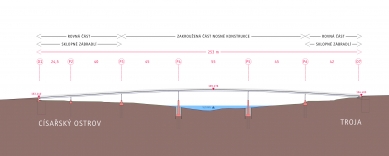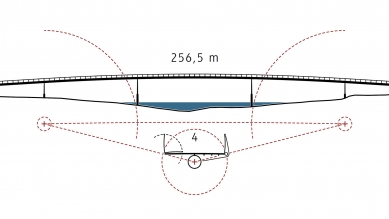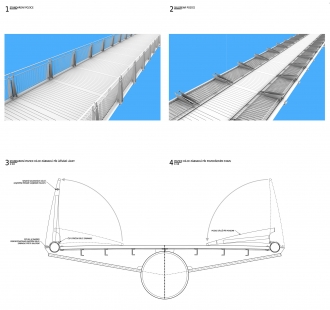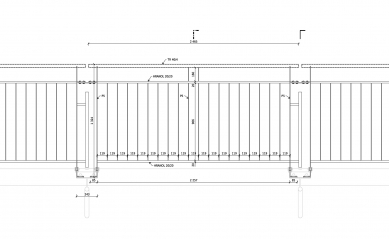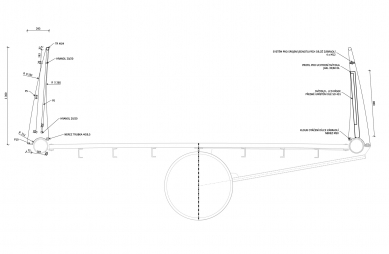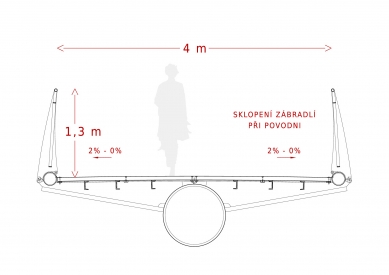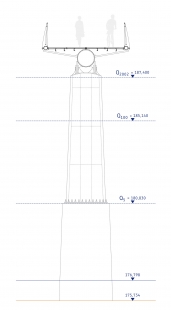
New Trojan Footbridge

The Troja Footbridge is part of an important natural area, one of the most significant in Prague, and serves as a vital connection for pedestrian and recreational trails between three city districts. It primarily functions as a walking link from the urban natural park Stromovka across Císařský Island to popular recreational destinations in Prague - Troja, particularly the ZOO, Botanical Garden, and the grounds of Troja Castle, among others. Following the unexpected collapse of the original reinforced concrete footbridge, the need to restore this connection as quickly as possible arose, with high demands for a safe and controllable structure resistant to increased flood risks, while also meeting new operational requirements. The new bridge is positioned in the original footprint, with its walkway profile widened to four meters compared to the original, in order to accommodate the needs of a mixed path for pedestrians and cyclists, while also allowing passage for vehicles of the Integrated Rescue Service and meeting the high traffic demands of the route.
The main criteria for designing the new bridge included the need for an efficient, quickly realizable structural solution that meets static and flood-resistant requirements, as well as practicality and maintainability of the structure, while ensuring a clean and elegant integration of all needs. The pros and cons of using different materials were considered, taking into account the ecological impacts of production processes and subsequent maintenance. The lightweight pedestrian bridge had enormous requirements in terms of load-bearing capacity (it must support emergency services) and flood resistance (a folding railing was designed to minimize the barrier in the water flow profile in case of flooding), but equally important in this context was a certain aesthetic and material friendliness for visitors, in connection with the adjacent park environment of Stromovka and Troja, as well as the safety of the pedestrian path, which required the choice of suitable lighting that also respects the natural character of the surroundings.
A simple, hierarchically structured steel construction was chosen, composed of a hermetically closed tubular spine beam, which exhibits resistance to loading in all directions (vertical operational and horizontal in the event of a flood) with a wall thickness corresponding to the longitudinal distribution of stress on the bridge. The structure is supplemented with cross beams and tubular longitudinal members serving to anchor the wooden deck and to attach the railing, including the folding mechanism. This subtle structure, through its simple aesthetic approach, creates a smooth horizontal line supported by very slender piers smoothly surrounded by water. The piers seamlessly transition at their lower concrete part to the foundation. At the height of the five-year flood discharge level, the concrete part of the stem transitions into a steel part ended with a pin for supporting the horizontal bearing structure. The cross-section of both parts is designed in an elliptical (intentionally simplified for production) hydraulically advantageous shape to maximize the elimination of adverse effects (the formation of vortices) during its water flow profiling.
For the deck, a supporting structure made of fully recyclable and natural materials, such as steel and wood, was chosen. By selecting wood with suitable properties – e.g., higher strength, durability, and chemical and biological resistance – it was possible to minimize the amount used. The wood chosen is from the Lophira Alata (azobé) tree, cultivated for its properties (comparable to concrete and steel) and commonly used as a raw construction material. On the Troja Footbridge, this wood was used comprehensively not only for its technical properties but also for its significant aesthetic quality (and perhaps even a chocolate scent when wet and warm). Azobé wood has the enormous advantage of not needing chemical treatments or repeated protective coatings, while being resistant to weather influences; it is resistant to water, moisture, and acid rain, as well as to fungi, rot, and even fire. (Using, for example, oak wood would have required twice the thickness, three times more frequent replacements, and the necessity of chemical impregnation or protective finishes). The slip resistance of the wooden deck is enhanced by transverse grooving.
The lighting for the Troja Footbridge features vertical linear fixtures integrated into the railing posts on both sides of the bridge, slightly set back from the edge, to visually conceal the fixtures behind the railing construction when passing through, preventing glare for pedestrians. The color tone of the light was chosen to be a pleasant warm white, considering the surroundings while maintaining pedestrian safety, with the option to reduce the lighting level during off-peak times using a pre-set timer mode.
The main criteria for designing the new bridge included the need for an efficient, quickly realizable structural solution that meets static and flood-resistant requirements, as well as practicality and maintainability of the structure, while ensuring a clean and elegant integration of all needs. The pros and cons of using different materials were considered, taking into account the ecological impacts of production processes and subsequent maintenance. The lightweight pedestrian bridge had enormous requirements in terms of load-bearing capacity (it must support emergency services) and flood resistance (a folding railing was designed to minimize the barrier in the water flow profile in case of flooding), but equally important in this context was a certain aesthetic and material friendliness for visitors, in connection with the adjacent park environment of Stromovka and Troja, as well as the safety of the pedestrian path, which required the choice of suitable lighting that also respects the natural character of the surroundings.
A simple, hierarchically structured steel construction was chosen, composed of a hermetically closed tubular spine beam, which exhibits resistance to loading in all directions (vertical operational and horizontal in the event of a flood) with a wall thickness corresponding to the longitudinal distribution of stress on the bridge. The structure is supplemented with cross beams and tubular longitudinal members serving to anchor the wooden deck and to attach the railing, including the folding mechanism. This subtle structure, through its simple aesthetic approach, creates a smooth horizontal line supported by very slender piers smoothly surrounded by water. The piers seamlessly transition at their lower concrete part to the foundation. At the height of the five-year flood discharge level, the concrete part of the stem transitions into a steel part ended with a pin for supporting the horizontal bearing structure. The cross-section of both parts is designed in an elliptical (intentionally simplified for production) hydraulically advantageous shape to maximize the elimination of adverse effects (the formation of vortices) during its water flow profiling.
For the deck, a supporting structure made of fully recyclable and natural materials, such as steel and wood, was chosen. By selecting wood with suitable properties – e.g., higher strength, durability, and chemical and biological resistance – it was possible to minimize the amount used. The wood chosen is from the Lophira Alata (azobé) tree, cultivated for its properties (comparable to concrete and steel) and commonly used as a raw construction material. On the Troja Footbridge, this wood was used comprehensively not only for its technical properties but also for its significant aesthetic quality (and perhaps even a chocolate scent when wet and warm). Azobé wood has the enormous advantage of not needing chemical treatments or repeated protective coatings, while being resistant to weather influences; it is resistant to water, moisture, and acid rain, as well as to fungi, rot, and even fire. (Using, for example, oak wood would have required twice the thickness, three times more frequent replacements, and the necessity of chemical impregnation or protective finishes). The slip resistance of the wooden deck is enhanced by transverse grooving.
The lighting for the Troja Footbridge features vertical linear fixtures integrated into the railing posts on both sides of the bridge, slightly set back from the edge, to visually conceal the fixtures behind the railing construction when passing through, preventing glare for pedestrians. The color tone of the light was chosen to be a pleasant warm white, considering the surroundings while maintaining pedestrian safety, with the option to reduce the lighting level during off-peak times using a pre-set timer mode.
The English translation is powered by AI tool. Switch to Czech to view the original text source.
0 comments
add comment


